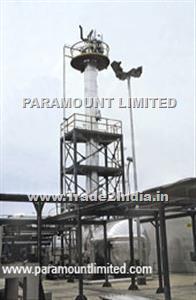PARAMOUNT LTD.
Featured Products
Highest quality standards are achieved through the implementations of latest technology, decades of experience and everlasting moral values , which have helped us to retain our customers as well as multiply them.
Welcome to PARAMOUNT LTD.
Air And Steam Strippers

The typical arrangement of a steam-stripping column is a column where the liquid feed is introduced at the top of the column while steam is introduced at the bottom of the column. The wastewater feed stream is heated and put in contact with steam in a packed or trayed tower.
The combined effects of the steam and heat cause organic material/ Hydrogen Sulphide to transfer from the liquid phase to the vapor phase. The steam-stripping tower utilizes trays or packing internals to facilitate contact between the contaminated water stream and the steam stream. The volatile organic material/ ammonia is then carried out with the vapor. As contacting proceeds down the column, the wastewater becomes leaner with organic material/ ammonia while the vapor phase becomes more enriched with organic material/ ammonia as it travels up the column.
In solvent/ hydro carbon strippers, the overhead organic vapor that comes off the top of the column is condensed and recovered. The recovered hydrocarbons are either treated with an incinerator or recycled back into the process. The treated water that comes off the bottom of the column can be recycled back into the plant’s water system. Steam stripping in wastewater service offers high VOC recovery (Greater than 99%). The treated water at the bottom of the column has very low contaminated concentrations.
In ammonia strippers, the overhead ammonia vapor that comes off the top of the column is condensed and recovered. The treated water that comes off the bottom of the column can be recycled back into the plant’s water system. Ammonia strippers are largely installed in a Nitrogen based fertilizer manufacturing (like urea, diammonium phosphate, etc) industry. The recovered ammonium hydroxide can be recycled back into the process.
Typical Steam Stripper applications are:
• Solvent recovery or removal (tetrahydrofuran, hexane, heptane)
• Benzene removal from wastewaters
• Sour water (H2S and NH3) stripping
• Phenol recovery
• Acetone removal/recovery from wastewaters
• Alcohol (ethanol, propanol, IPA, butanol) removal from water
• Oxygenate (MTBE, MEK) removal/recovery
• Removal of chloroform, bromoform and other halogenated organics from water
• Removal of various organics from quench waters
• Concentration and organics recovery from leachates
Our Vision
* To embrace new technologies and methods. * To give unsurpassed products and services to the clients. * To constantly look for improvement and changes.










